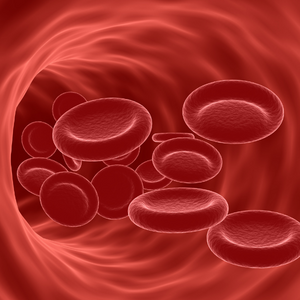AVMs

As people get older, the walls of small blood vessels in the digestive system can become weak and lead to collections of these vessels that are swollen and fragile. These collections can cause bleeding and, over time, lead to anemia. These superficial blood vessels are called by several names based on subtle differences as arteriovenous malformations (AVM), angioectasia, telangiectasia and angiodysplasia. Collectively they describe similar problems and are treated in similar ways.
These conditions are more common in older adults. Taking medications that prevent blood from clotting or that thin the blood can increase the risk of bleeding.
Symptoms
Symptoms vary from visible bleeding to no visible bleeding as far as the gastrointestinal tract is concerned. Bleeding may manifest as black stools or dark red to bright red blood in stools.
Often, there is no visible blood in stools with symptoms of anemia including weakness, fatigue, and shortness of breath as prominent symptoms. When anemia is severe, it may also cause one to pass out or develop chest pain. Abdominal pain is not a feature of this condition.
Tests
Tests that may be done to diagnose this condition include:
- Complete blood count (CBC) to check for anemia.
- Labs to assess iron stores.
- Upper endoscopy.
- Colonoscopy.
- Pillcam endoscopy.
- Double balloon endoscopy.
- CT or MRI angiography.
- Angiography for treatment of bleeding (only useful if there is active bleeding into the colon).
Treatment
The choice of treatment depends on the location and size of the AVM, as well as the overall health of the patient. Treatment options may include:
- Blood transfusions during severe bleeding or to treat symptomatic anemia.
- Iron replacement by oral iron of IV infusions.
- Endoscopic treatment options: endoscopy is a type of minimally invasive procedure that uses an endoscope, a long, thin tube with a camera and light on the end, to view and treat the inside of the body. Endoscopic treatment options are generally considered safe and effective for treating bleeding in the digestive tract. They are often used as a first-line treatment option and can be done as an outpatient procedure or with a short hospital stay. Treatment options include:
- Endoscopic injection therapy: this procedure uses an injection of a substance called epinephrine to the bleeding area to promote spasm of the blood vessel and stop the bleeding. It is usually followed by other modes of treatment.
- Argon plasma coagulation (APC): APC uses a high-frequency electric current to cauterize (burn) the bleeding vessel, sealing it off and stopping the bleeding.
- Endoscopic clipping: this procedure uses a small clip to compress the bleeding vessel, cutting off the blood flow and stopping the bleeding.
- Hemostatic powder or other hemostatic agents: these agents are applied to the bleeding area to promote clotting and stop the bleeding.
- Vascular embolization: a medical procedure that is used to block or reduce blood flow to a specific area in the body. This is done by inserting a small tube, called a catheter, into a blood vessel and then threading a small device through the catheter to the area that needs to be treated. The device is used to block or reduce blood flow to the area, cutting off the blood supply to the problem area. This procedure is typically done using x-ray guidance and can be done as an outpatient procedure or with a short hospital stay.
- Surgery.
FAQs
An arteriovenous malformation (AVM) is a rare condition in which there is an abnormal connection between arteries and veins in the gastrointestinal tract, allowing blood to bypass the capillaries. This can lead to problems such as bleeding and anemia.
Symptoms of an AVM in the gastrointestinal tract may include black stools, rectal bleeding, and anemia. Most people with AVMs have no initial symptoms or problems. Instead, the problem is discovered when health care providers treat another unrelated health concern.
AVMs are the most common vascular abnormality of the gastrointestinal tract, responsible for approximately 6% of lower gastrointestinal bleeding cases and up to 8% of upper gastrointestinal bleeds.
The exact cause of AVMs in the gastrointestinal tract is not fully understood, but AVMs are mostly related to the aging and breakdown of the blood vessels. It is more common in older adults. They are also more common in people with certain inherited conditions such as Osler-Weber-Rendu syndrome.
AVMs can cause acute, recurrent bleeding or chronic anemia resulting in very frequent hospitalizations and transfusions.
AVMs in the gastrointestinal tract can be diagnosed by Endoscopy, a type of minimally invasive procedure that uses an endoscope, a long, thin tube with a camera and light on the end, to view and treat the inside of the body, CT scan, and angiography.
Treatment for AVMs in the gastrointestinal tract may include endoscopic procedures to inject, cauterize and/or clip the abnormal blood vessels, embolization or clogging of the bleeding artery via angiography and surgery to remove the bowel segment containing the AVM. The specific treatment plan will depend on the location and size of the AVM and the severity of symptoms.
There is no known way to prevent AVMs in the gastrointestinal tract.
Yes, it is possible to have more than one AVM in the gastrointestinal tract.
AVMs in the gastrointestinal tract can often be treated successfully, but it is not always possible to completely cure the condition.
AVMs in the gastrointestinal tract can cause serious problems such as bleeding and anemia, and may need to be treated to prevent complications. However, with appropriate treatment, the prognosis for people with AVMs in the gastrointestinal tract is generally good.
It is possible for an AVM in the gastrointestinal tract to recur after treatment. Additionally new ones may form over time.